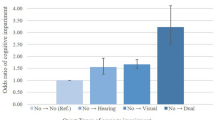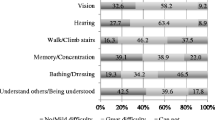Abstract
Purpose
The purpose of this study was to compare centenarians in the United States and Japan on sensory, cognitive, and physical functioning and to evaluate a model that tests the interrelationship between physical function, cognition, and sensory impairment in these two unique samples of the oldest old.
Methods
The sample of U. S. centenarians included 245 centenarians, the sample of Japanese centenarians included 304 centenarians. Sensory impairment was assessed by general assessments of vision and hearing, and physical function was assessed with six physical activities of daily living (i.e., eating, grooming, dressing, transporting, bathing, and walking).
Results
The results suggest that centenarians from the Georgia study showed higher levels of functioning in all domains when compared to the Tokyo sample. A structural equation model yielded stronger associations between cognitive and sensory function with physical function for the Tokyo sample.
Conclusions
Functional differences may be due, in part, to different care patterns for the oldest old in the United States when compared to Japan.




Similar content being viewed by others
References
Andersen-Ranberg, K., Vasegaard, L., & Jeune, B. (2001). Dementia is not inevitable: A population-based study of Danish centenarians. Journal of Gerontology: Series B: Psychological Sciences and Social Sciences, 56B, P152–P159. https://doi.org/10.1093/geronb/56.3.P152.
Arnold, J., Dai, J., Nahapetyan, L., Arte, A., Johnson, M. A., Hausman, D., et al. (2010). Predicting successful aging in a population-based sample of Georgia centenarians. Current Gerontology and Geriatrics Research. https://doi.org/10.1155/2010/989315.
Baltes, P. B., & Lindenberger, U. (1997). Emergence of a powerful connection between sensory and cognitive functions across the adult life span: A new window to the study of cognitive aging? Psychology and Aging, 12, 12–21.
Bentler, P. M., & Bonett, D. G. (1980). Significance tests and goodness of fit in the analysis of covariance structures. Psychological Bulletin, 88(3), 588.
Cagney, K. A., & Lauderdale, D. S. (2002). Education, wealth, and cognitive function in later life. Journal of Gerontology, Series B: Psychological Sciences and Social Sciences, 57, P163–P172.
Cimarolli, V. R., & Jopp, D. S. (2014). Sensory impairments and their associations with functional disability in a sample of the oldest-old. Quality of Life Research, 23, 1977–1984. https://doi.org/10.1007/s11136-014-0657-0.
Carmines, E. G., & McIver, J. P. (1981). Analyzing models with unobserved variables: Analysis of covariance structures. Social Measurement: Current Issues, 80, 65–115.
Cho, J., Martin, P., Margrett, J., MacDonald, M., Poon, L. W., et al. (2012). Cohort comparisons in resources and functioning among centenarians: Findings from the Georgia Centenarian Study. International Journal of Behavioral Development, 36(4), 271–278.
Collin, C., Wade, D. T., Davies, S., & Horne, V. (1988). The barthel ADL index: A reliability study. International Disabilities Studies, 10, 61–63.
Davey, A., Dai, T., Woodard, J. L., Miller, S., Gondo, Y., Johnson, M. A., et al. (2013). Profiles of cognitive functioning in a population-based sample of centenarians using factor mixture analysis. Experimental Aging Research, 39, 1–20. https://doi.org/10.1080/0361073X.2013.761869.
Deeg, D. J. H., van Vliet, M. J. G., Kardaun, J. W. P. F., & Huisman, M. (2013). Understanding the mortality decline of older age: Improved life course or improved present period? In J.-M. Robine, C. Jagger & E. M. Crimmins (Eds.), Annual review of gerontology and geriatrics—Healthy longevity: A global approach (Vol. 33, pp. 261–291). New York: Springer.
Dodge, H. H., Kadowaki, T., Hayakawa, T., Yamakawa, M., Sekikawa, A., & Ueshima, H. (2005). Cognitive impairment as a strong predictor of incident disability in specific ADL-IADL tasks among community-dwelling elders: The Azuchi study. The Gerontologist, 45, 222–230.
Fan, X., Thompson, B., & Wang, L. (1999). Effects of sample size, estimation methods, and model specification on structural equation modeling fit indexes. Structural Equation Modeling: A Multidisciplinary Journal, 6(1), 56–83.
Fillenbaum, G. G. (1988). Multidimensional functional assessment of older adults: The Duke Older Americans resources and services procedures. Hillsdale: Lawrence Erlbaum Associates.
Folstein, M. F., Folstein, S. E., & McHugh, P. R. (1975). “Mini-mental state”: A practical method for grading the cognitive state of patients for the clinician. Journal of Psychiatric, 12(3), 189–198
Fulton, S. E., Lister, J. J., Bush, A. L., Edwards, J. D., & Andel, R. (2015). Mechanisms of the hearing-cognition relationship. Seminars in Hearing, 36, 140–149. https://doi.org/10.1055/s-0035-1555117.
Gondo, Y. (2007). Current status and future prospects on centenarian study. Japanese Journal of Gerontology, 28(4), 504–512.
Gondo, Y., & Hirose, N. (2006). How successful are centenarians? Findings from the Tokyo centenarian study. Global Ageing: Issues and Action, 4, 34–41.
Gondo, Y., Hirose, N., Arai, Y., Inagaki, H., Masui, Y., Yamamura, K., et al. (2006). Functional status of centenarians in Tokyo, Japan: Developing better phenotypes of exceptional longevity. Journal of Gerontology: Medical Sciences, 61A(3), 305–310.
Gondo, Y., & Poon, L. W. (2007). Cognitive function of centenarians and its influence on longevity. In L. W. Poon & T. T. Perls (Eds.), Annual Review of gerontology and geriatrics, vol. 27: Biopsychosocial approaches to longevity (pp. 129–150). New York: Springer.
Gu, D. (2008). General data quality assessment of the CLHLS. In Z. Yi, D. L. Poston Jr., D. A. Vlosky & D. Gu (Eds.), Healthy longevity in China: Demographic, socioeconomic, and psychological dimensions (pp. 39–59). New York: Springer.
Hirose, N., Arai, Y., Gondo, Y., Nakazawa, S., Takayama, M., Ebihara, Y., et al. (2004). Tokyo centenarian study: Aging inflammation hypothesis. Geriatrics and Gerontology International, 4, S182–S185. https://doi.org/10.1111/j.1447-0594.2004.00194.x.
Holtsberg, P. A., Poon, L. W., Noble, C. A., & Martin, P. (1995). Mini-mental state exam status of community dwelling, cognitively intact centenarians. International Psychogeriatrics, 7, 417–427.
Ikegami, N., & Ikezaki, S. (2010). Life sustaining treatment at end-of-life in Japan: Do the perspectives of the general public reflect those of the bereaved of patients who had died in hospitals? Health Policy, 98, 98–106.
Jagger, C., Matthews, R. J., Matthews, F. E., Spiers, N. A., Nickson, J., Paykel, E. S., et al. (2007). Cohort differences in disease and disability in the young-old: Findings from the MRC cognitive function and ageing study (MRC-CFAS). BMC Public Health, 7, 156.
Kline, R. (2005). Principles and practices of structural equation modeling (2nd edn.). New York: Guilford Press.
Lin, F. R., Yaffe, K., Xia, J., Xue, Q. L., Harris, T. B., Purchase-Helzner, E., et al. (2013). Hearing loss and cognitive decline in older adults. Journal of the American Medical Association: Internal Medicine, 173, 293–299. https://doi.org/10.1001/jamainternmed.2013.1868.
Loewenstein, D. A., Argüelles, S., Bravo, M., Freeman, R. Q., Argüelles, T., Acevedo, A., et al. (2001). Caregivers’ judgment of the functional abilities of the Alzheimer’s Disease patient: A comparison of proxy reports and objective measures. Journal of Gerontology: Psychological Sciences, 56B, P78–P84.
Martin, P., Poon, L. W., Kim, E., & Johnson, M. A. (1996). Social and psychological resources of the oldest old. Experimental Aging Research, 22, 121–139.
Martin, P., MacDonald, M., Margrett, J., Siegler, I. C., & Poon, L. W. (2013). Correlates of functional capacity among centenarians. Journal of Applied Gerontology, 32, 324–346 1–22. https://doi.org/10.1177/0733464811420563.
Mori, E., Mitani, Y., & Yamadori (1985). Usefulness of a Japanese version of the Mini-Mental State Test in neurological patients. Shinkei Shinrigaku, 1, 2–10.
Nakagawa, T., & Gondo, Y. (2013). Health care system and policy implications for older adults in Japan. In A. E. Scharlach & K. Hoshino (Eds.), Healthy aging in sociocultural context (pp. 53–61). New York: Routledge.
Ozaki, A., Kahiyama, M., Tagaya, H., Ohida, T., & Ogihara, R. (2006). The Japanese centenarian study: Autonomy was associated with health practices as well as physical status. Journal of the American Geriatrics Society, 55, 95–101.
Poon, L. W., Jazwinski, S. M., Green, R. C., Woodard, J. L., Martin, P., Rodgers, W. L., et al. (2007). Methodological considerations in studying centenarians: Lessons learned from the Georgia Centenarian Studies. In L. W. Poon & T. T. Perls (Eds.), Annual Review of Gerontology and Geriatrics, Vol. 27. Biopsychosocial approaches to longevity (pp. 231–264). New York: Springer.
Selim, A. J., Fincke, G., Berlowitz, D. R., Miller, D. R., Qian, S. X., et al. (2005). Comprehensive health status assessment of centenarians: Results From the 1999 large health survey of veteran enrollees. Journal of Gerontology. Series A: Biological Sciences and Medical. Sciences, 60, 515–519.
Suzuki, M., Akisaka, M., Ashitomi, I., Higa, K., & Nozaki, H. (1995). Chronological study concerning ADL among Okinawan centenarians. Nippon Ronen Igakkai Zasshi, 32, 416–423.
Takayama, M., Hirose, N., Arai, Y., Gondo, Y., Shimizu, K., Ebihara, Y., et al. (2007). Morbidity of Tokyo-area centenarians and its relationship to functional status. Journal of Gerontology: Medical Sciences, 62A, 774–782.
Toyoshima, A., Martin, P., Sato, S., & Poon, L. W. (2017). The relationship between vision impairment and well-being among centenarians: Findings from the Georgia Centenarian Study. International Journal of Geriatric Psychiatry. https://doi.org/10.1002/gps.4763.
Watkins, R. A., Guariglia, R., Kaye, J. A., & Janowsky, J. S. (2001). Informants’ knowledge of reproductive history and estrogen replacement. Journal of Gerontology: Medical Sciences, 56A, M176–M179.
World Health Organization (2016). World health statistics 2016. Retrieved from http://www.who.int/gho/publications/world_health_statistics/2016/en/.
Yashin, A. I., Ukraintseva, S. V., De Benedictis, G., Anisimov, V. N., Nutov, A. A., Arbeev, K., et al. (2001). Have the oldest old adults ever been frail in the past? A hypothesis that explains modern trends in survival. The Journals of Gerontology: Series A: Biological Sciences and Medical Sciences, 56, 432–442.
Acknowledgements
The Georgia Centenarian Study (Leonard W. Poon, PI) was funded by 1P01AG17553 from the National Institute on Aging, a collaboration among The University of Georgia, Tulane University Health Sciences Center, Boston University, University of Kentucky, Emory University, Duke University, Wayne State University, Iowa State University, Temple University, and University of Michigan. Additional authors include S. M. Jazwinski, R. C. Green, M. MacDonald, M. Gearing, W. R. Markesbery (deceased), J. L. Woodard, M. (A) Johnson, J. S. Tenover, I. C. Siegler, W. L. Rodgers, D. (B) Hausman, (C) Rott, A. Davey, and J. Arnold. Authors acknowledge the valuable recruitment and data acquisition effort from M. Burgess, K. Grier, E. Jackson, E. McCarthy, K. Shaw, L. Strong, and S. Reynolds, data acquisition team manager; S. Anderson, E. Cassidy, M. Janke, and J. Savla, data management; M. Poon for project fiscal management. The first author also acknowledges the support by the Fulbright Commission for his work on this project. The Tokyo Centenarian Study was supported in part by a grant from the Japanese Ministry of Health and Welfare for the Scientific Research Project on Longevity, a grant for studying the multidisciplinary approach to centenarians and its international comparison (Principal Investigator, Nobuyoshi Hirose); a grant from the Japanese Ministry of Education, Science and Culture (No. 15730346); and aid for research from the Keio Health Consulting Center. Both studies have been approved by their respective Institutional Review Boards.
Author information
Authors and Affiliations
Corresponding author
Ethics declarations
Conflict of interest
The authors declare that they have no conflict of interest.
Ethical approval
All procedures performed in studies involving human participants were in accordance with the ethical standards of the institutional and/or national research committee and with the 1964 Helsinki Declaration and its later amendments or comparable ethical standards.
Informed consent
Informed consent was obtained from all individual participants included in the study.
Rights and permissions
About this article
Cite this article
Martin, P., Gondo, Y., Arai, Y. et al. Physical, sensory, and cognitive functioning among centenarians: a comparison between the Tokyo and Georgia centenarian studies. Qual Life Res 27, 3037–3046 (2018). https://doi.org/10.1007/s11136-018-1943-z
Accepted:
Published:
Issue Date:
DOI: https://doi.org/10.1007/s11136-018-1943-z




